Manage Personal Work Priorities and Development: BSBWOR501 Report
VerifiedAdded on 2022/08/21
|21
|5724
|11
Report
AI Summary
This report, based on the BSBWOR501 unit, addresses the crucial aspects of managing personal work priorities and professional development within an organizational context. It begins by defining professional development and its significance, emphasizing the importance of aligning personal goals with organizational objectives. The report explores the role of positive role models in the workplace, outlining key behaviors such as exhibiting a positive attitude, building trust, and open communication. It then delves into strategies for ensuring work goals reflect organizational plans, including creating mission statements, allocating responsibilities, and providing training. The report also discusses methods for assessing personal knowledge and skills to determine professional development needs and emphasizes the importance of maintaining a healthy work-life balance through prioritization and time management. Furthermore, it examines practices for prioritizing project work and the effective use of technology in managing time and commitments. The report concludes by highlighting the role of performance management systems and the importance of personal development plans. This report is a comprehensive guide for students seeking to improve their management skills and excel in their professional careers.
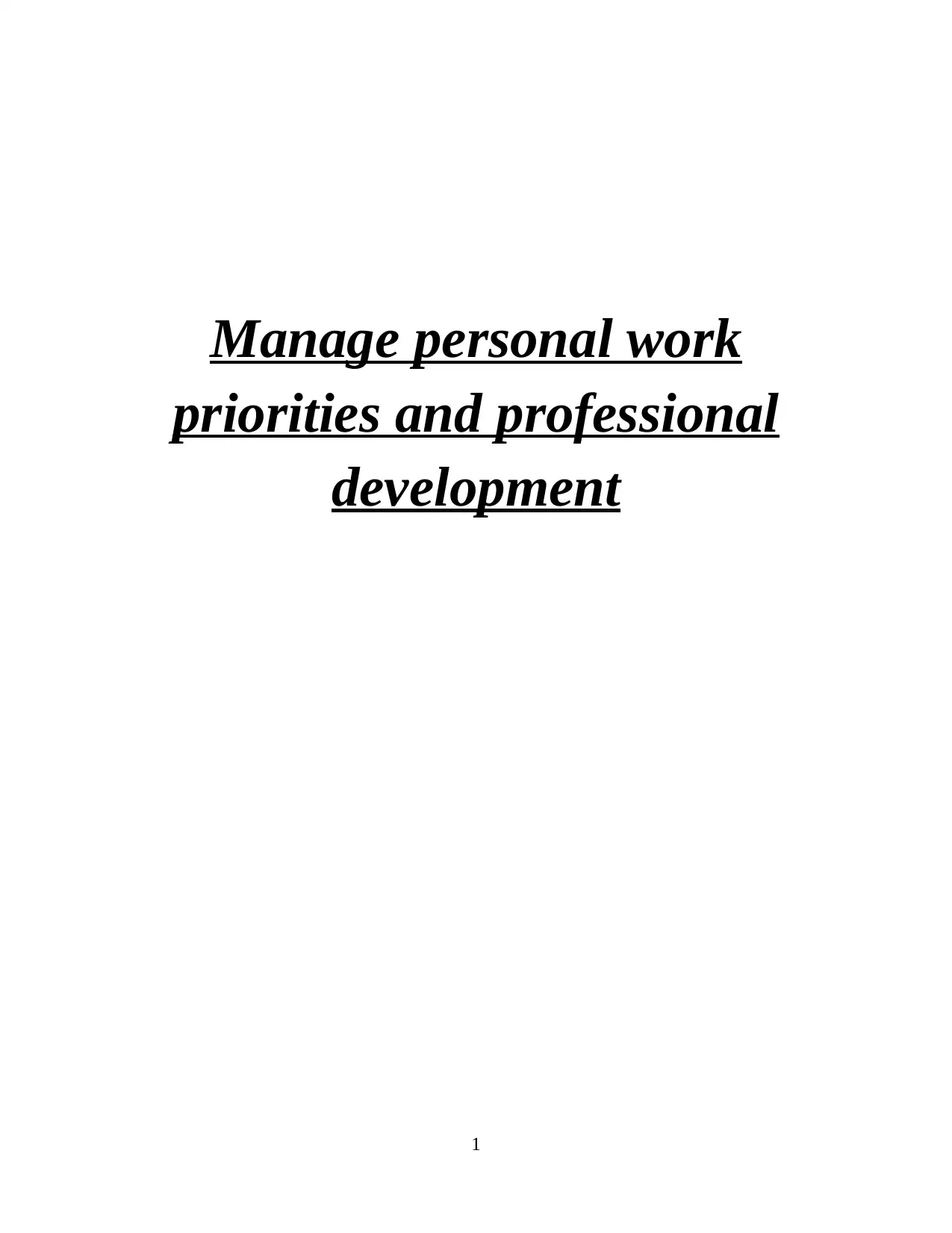
Manage personal work
priorities and professional
development
1
priorities and professional
development
1
Paraphrase This Document
Need a fresh take? Get an instant paraphrase of this document with our AI Paraphraser
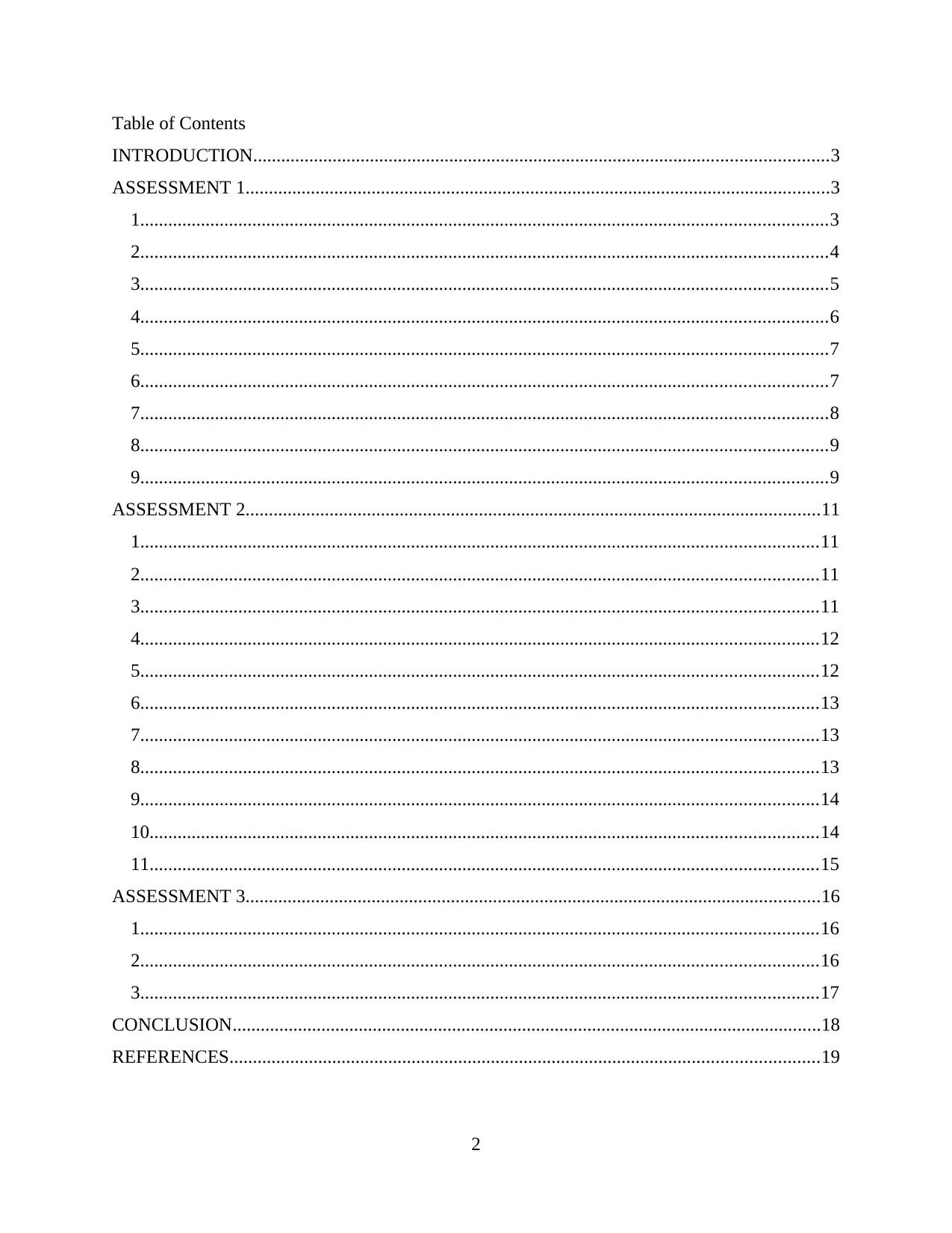
Table of Contents
INTRODUCTION...........................................................................................................................3
ASSESSMENT 1.............................................................................................................................3
1...................................................................................................................................................3
2...................................................................................................................................................4
3...................................................................................................................................................5
4...................................................................................................................................................6
5...................................................................................................................................................7
6...................................................................................................................................................7
7...................................................................................................................................................8
8...................................................................................................................................................9
9...................................................................................................................................................9
ASSESSMENT 2...........................................................................................................................11
1.................................................................................................................................................11
2.................................................................................................................................................11
3.................................................................................................................................................11
4.................................................................................................................................................12
5.................................................................................................................................................12
6.................................................................................................................................................13
7.................................................................................................................................................13
8.................................................................................................................................................13
9.................................................................................................................................................14
10...............................................................................................................................................14
11...............................................................................................................................................15
ASSESSMENT 3...........................................................................................................................16
1.................................................................................................................................................16
2.................................................................................................................................................16
3.................................................................................................................................................17
CONCLUSION..............................................................................................................................18
REFERENCES..............................................................................................................................19
2
INTRODUCTION...........................................................................................................................3
ASSESSMENT 1.............................................................................................................................3
1...................................................................................................................................................3
2...................................................................................................................................................4
3...................................................................................................................................................5
4...................................................................................................................................................6
5...................................................................................................................................................7
6...................................................................................................................................................7
7...................................................................................................................................................8
8...................................................................................................................................................9
9...................................................................................................................................................9
ASSESSMENT 2...........................................................................................................................11
1.................................................................................................................................................11
2.................................................................................................................................................11
3.................................................................................................................................................11
4.................................................................................................................................................12
5.................................................................................................................................................12
6.................................................................................................................................................13
7.................................................................................................................................................13
8.................................................................................................................................................13
9.................................................................................................................................................14
10...............................................................................................................................................14
11...............................................................................................................................................15
ASSESSMENT 3...........................................................................................................................16
1.................................................................................................................................................16
2.................................................................................................................................................16
3.................................................................................................................................................17
CONCLUSION..............................................................................................................................18
REFERENCES..............................................................................................................................19
2
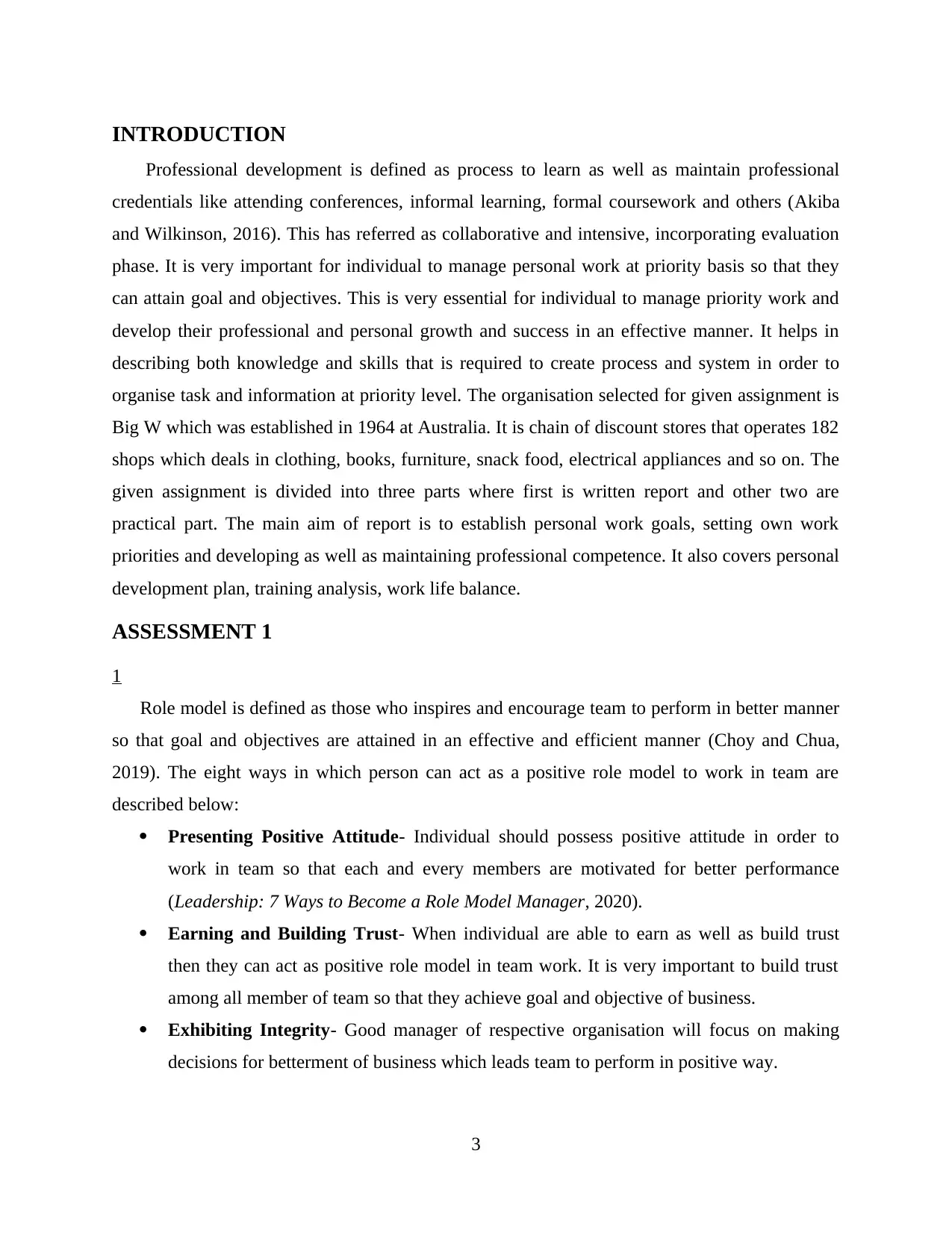
INTRODUCTION
Professional development is defined as process to learn as well as maintain professional
credentials like attending conferences, informal learning, formal coursework and others (Akiba
and Wilkinson, 2016). This has referred as collaborative and intensive, incorporating evaluation
phase. It is very important for individual to manage personal work at priority basis so that they
can attain goal and objectives. This is very essential for individual to manage priority work and
develop their professional and personal growth and success in an effective manner. It helps in
describing both knowledge and skills that is required to create process and system in order to
organise task and information at priority level. The organisation selected for given assignment is
Big W which was established in 1964 at Australia. It is chain of discount stores that operates 182
shops which deals in clothing, books, furniture, snack food, electrical appliances and so on. The
given assignment is divided into three parts where first is written report and other two are
practical part. The main aim of report is to establish personal work goals, setting own work
priorities and developing as well as maintaining professional competence. It also covers personal
development plan, training analysis, work life balance.
ASSESSMENT 1
1
Role model is defined as those who inspires and encourage team to perform in better manner
so that goal and objectives are attained in an effective and efficient manner (Choy and Chua,
2019). The eight ways in which person can act as a positive role model to work in team are
described below:
Presenting Positive Attitude- Individual should possess positive attitude in order to
work in team so that each and every members are motivated for better performance
(Leadership: 7 Ways to Become a Role Model Manager, 2020).
Earning and Building Trust- When individual are able to earn as well as build trust
then they can act as positive role model in team work. It is very important to build trust
among all member of team so that they achieve goal and objective of business.
Exhibiting Integrity- Good manager of respective organisation will focus on making
decisions for betterment of business which leads team to perform in positive way.
3
Professional development is defined as process to learn as well as maintain professional
credentials like attending conferences, informal learning, formal coursework and others (Akiba
and Wilkinson, 2016). This has referred as collaborative and intensive, incorporating evaluation
phase. It is very important for individual to manage personal work at priority basis so that they
can attain goal and objectives. This is very essential for individual to manage priority work and
develop their professional and personal growth and success in an effective manner. It helps in
describing both knowledge and skills that is required to create process and system in order to
organise task and information at priority level. The organisation selected for given assignment is
Big W which was established in 1964 at Australia. It is chain of discount stores that operates 182
shops which deals in clothing, books, furniture, snack food, electrical appliances and so on. The
given assignment is divided into three parts where first is written report and other two are
practical part. The main aim of report is to establish personal work goals, setting own work
priorities and developing as well as maintaining professional competence. It also covers personal
development plan, training analysis, work life balance.
ASSESSMENT 1
1
Role model is defined as those who inspires and encourage team to perform in better manner
so that goal and objectives are attained in an effective and efficient manner (Choy and Chua,
2019). The eight ways in which person can act as a positive role model to work in team are
described below:
Presenting Positive Attitude- Individual should possess positive attitude in order to
work in team so that each and every members are motivated for better performance
(Leadership: 7 Ways to Become a Role Model Manager, 2020).
Earning and Building Trust- When individual are able to earn as well as build trust
then they can act as positive role model in team work. It is very important to build trust
among all member of team so that they achieve goal and objective of business.
Exhibiting Integrity- Good manager of respective organisation will focus on making
decisions for betterment of business which leads team to perform in positive way.
3
⊘ This is a preview!⊘
Do you want full access?
Subscribe today to unlock all pages.

Trusted by 1+ million students worldwide
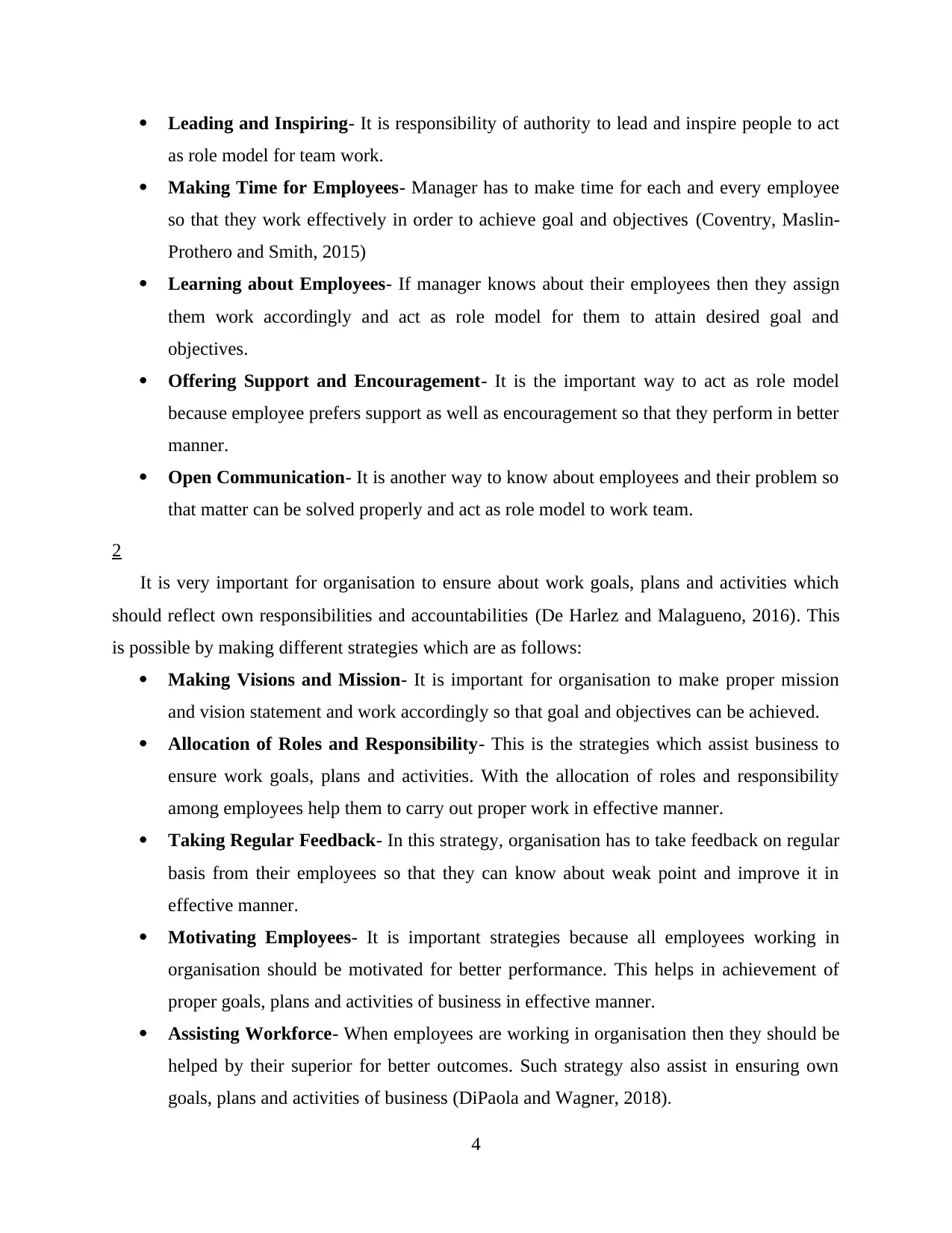
Leading and Inspiring- It is responsibility of authority to lead and inspire people to act
as role model for team work.
Making Time for Employees- Manager has to make time for each and every employee
so that they work effectively in order to achieve goal and objectives (Coventry, Maslin‐
Prothero and Smith, 2015)
Learning about Employees- If manager knows about their employees then they assign
them work accordingly and act as role model for them to attain desired goal and
objectives.
Offering Support and Encouragement- It is the important way to act as role model
because employee prefers support as well as encouragement so that they perform in better
manner.
Open Communication- It is another way to know about employees and their problem so
that matter can be solved properly and act as role model to work team.
2
It is very important for organisation to ensure about work goals, plans and activities which
should reflect own responsibilities and accountabilities (De Harlez and Malagueno, 2016). This
is possible by making different strategies which are as follows:
Making Visions and Mission- It is important for organisation to make proper mission
and vision statement and work accordingly so that goal and objectives can be achieved.
Allocation of Roles and Responsibility- This is the strategies which assist business to
ensure work goals, plans and activities. With the allocation of roles and responsibility
among employees help them to carry out proper work in effective manner.
Taking Regular Feedback- In this strategy, organisation has to take feedback on regular
basis from their employees so that they can know about weak point and improve it in
effective manner.
Motivating Employees- It is important strategies because all employees working in
organisation should be motivated for better performance. This helps in achievement of
proper goals, plans and activities of business in effective manner.
Assisting Workforce- When employees are working in organisation then they should be
helped by their superior for better outcomes. Such strategy also assist in ensuring own
goals, plans and activities of business (DiPaola and Wagner, 2018).
4
as role model for team work.
Making Time for Employees- Manager has to make time for each and every employee
so that they work effectively in order to achieve goal and objectives (Coventry, Maslin‐
Prothero and Smith, 2015)
Learning about Employees- If manager knows about their employees then they assign
them work accordingly and act as role model for them to attain desired goal and
objectives.
Offering Support and Encouragement- It is the important way to act as role model
because employee prefers support as well as encouragement so that they perform in better
manner.
Open Communication- It is another way to know about employees and their problem so
that matter can be solved properly and act as role model to work team.
2
It is very important for organisation to ensure about work goals, plans and activities which
should reflect own responsibilities and accountabilities (De Harlez and Malagueno, 2016). This
is possible by making different strategies which are as follows:
Making Visions and Mission- It is important for organisation to make proper mission
and vision statement and work accordingly so that goal and objectives can be achieved.
Allocation of Roles and Responsibility- This is the strategies which assist business to
ensure work goals, plans and activities. With the allocation of roles and responsibility
among employees help them to carry out proper work in effective manner.
Taking Regular Feedback- In this strategy, organisation has to take feedback on regular
basis from their employees so that they can know about weak point and improve it in
effective manner.
Motivating Employees- It is important strategies because all employees working in
organisation should be motivated for better performance. This helps in achievement of
proper goals, plans and activities of business in effective manner.
Assisting Workforce- When employees are working in organisation then they should be
helped by their superior for better outcomes. Such strategy also assist in ensuring own
goals, plans and activities of business (DiPaola and Wagner, 2018).
4
Paraphrase This Document
Need a fresh take? Get an instant paraphrase of this document with our AI Paraphraser
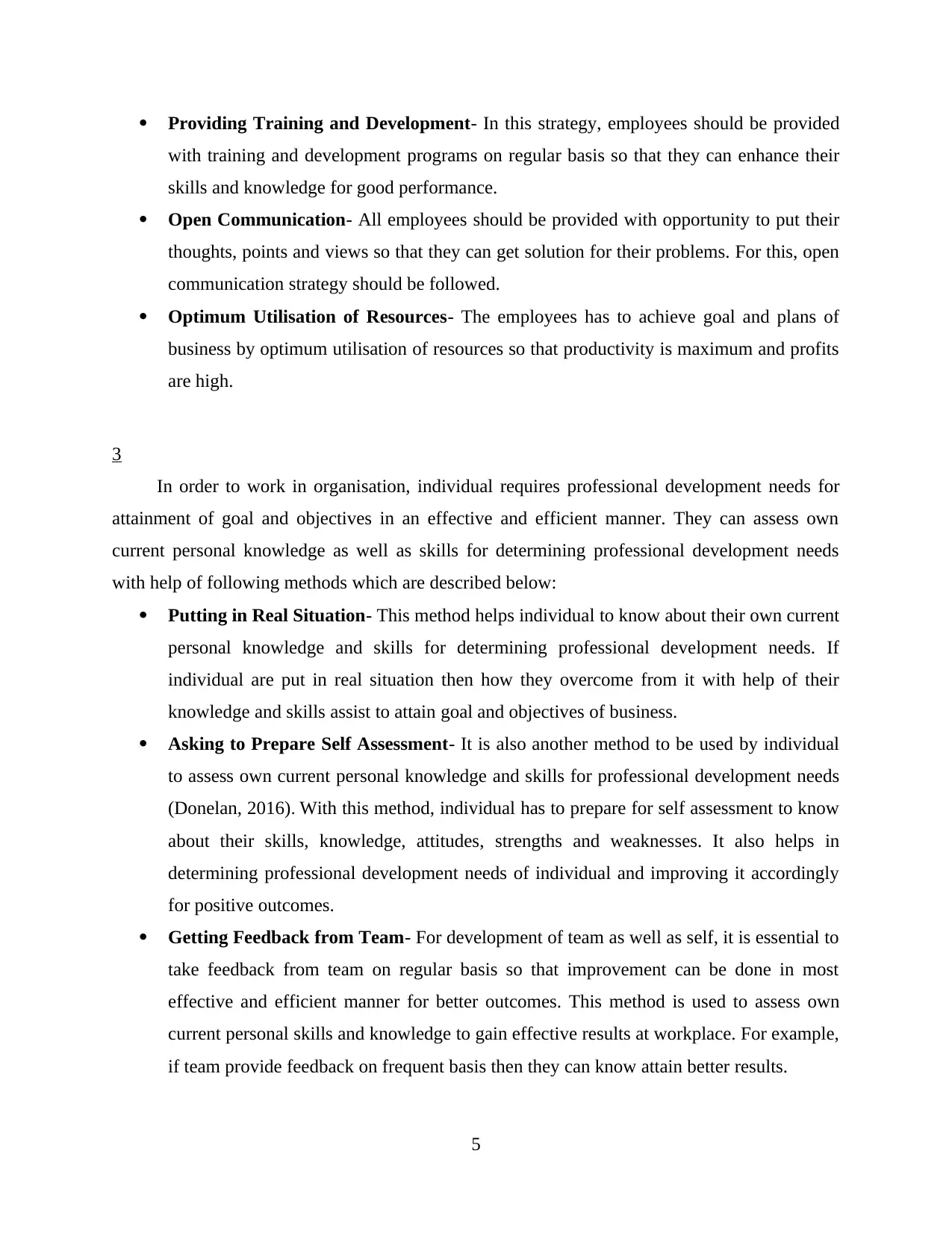
Providing Training and Development- In this strategy, employees should be provided
with training and development programs on regular basis so that they can enhance their
skills and knowledge for good performance.
Open Communication- All employees should be provided with opportunity to put their
thoughts, points and views so that they can get solution for their problems. For this, open
communication strategy should be followed.
Optimum Utilisation of Resources- The employees has to achieve goal and plans of
business by optimum utilisation of resources so that productivity is maximum and profits
are high.
3
In order to work in organisation, individual requires professional development needs for
attainment of goal and objectives in an effective and efficient manner. They can assess own
current personal knowledge as well as skills for determining professional development needs
with help of following methods which are described below:
Putting in Real Situation- This method helps individual to know about their own current
personal knowledge and skills for determining professional development needs. If
individual are put in real situation then how they overcome from it with help of their
knowledge and skills assist to attain goal and objectives of business.
Asking to Prepare Self Assessment- It is also another method to be used by individual
to assess own current personal knowledge and skills for professional development needs
(Donelan, 2016). With this method, individual has to prepare for self assessment to know
about their skills, knowledge, attitudes, strengths and weaknesses. It also helps in
determining professional development needs of individual and improving it accordingly
for positive outcomes.
Getting Feedback from Team- For development of team as well as self, it is essential to
take feedback from team on regular basis so that improvement can be done in most
effective and efficient manner for better outcomes. This method is used to assess own
current personal skills and knowledge to gain effective results at workplace. For example,
if team provide feedback on frequent basis then they can know attain better results.
5
with training and development programs on regular basis so that they can enhance their
skills and knowledge for good performance.
Open Communication- All employees should be provided with opportunity to put their
thoughts, points and views so that they can get solution for their problems. For this, open
communication strategy should be followed.
Optimum Utilisation of Resources- The employees has to achieve goal and plans of
business by optimum utilisation of resources so that productivity is maximum and profits
are high.
3
In order to work in organisation, individual requires professional development needs for
attainment of goal and objectives in an effective and efficient manner. They can assess own
current personal knowledge as well as skills for determining professional development needs
with help of following methods which are described below:
Putting in Real Situation- This method helps individual to know about their own current
personal knowledge and skills for determining professional development needs. If
individual are put in real situation then how they overcome from it with help of their
knowledge and skills assist to attain goal and objectives of business.
Asking to Prepare Self Assessment- It is also another method to be used by individual
to assess own current personal knowledge and skills for professional development needs
(Donelan, 2016). With this method, individual has to prepare for self assessment to know
about their skills, knowledge, attitudes, strengths and weaknesses. It also helps in
determining professional development needs of individual and improving it accordingly
for positive outcomes.
Getting Feedback from Team- For development of team as well as self, it is essential to
take feedback from team on regular basis so that improvement can be done in most
effective and efficient manner for better outcomes. This method is used to assess own
current personal skills and knowledge to gain effective results at workplace. For example,
if team provide feedback on frequent basis then they can know attain better results.
5
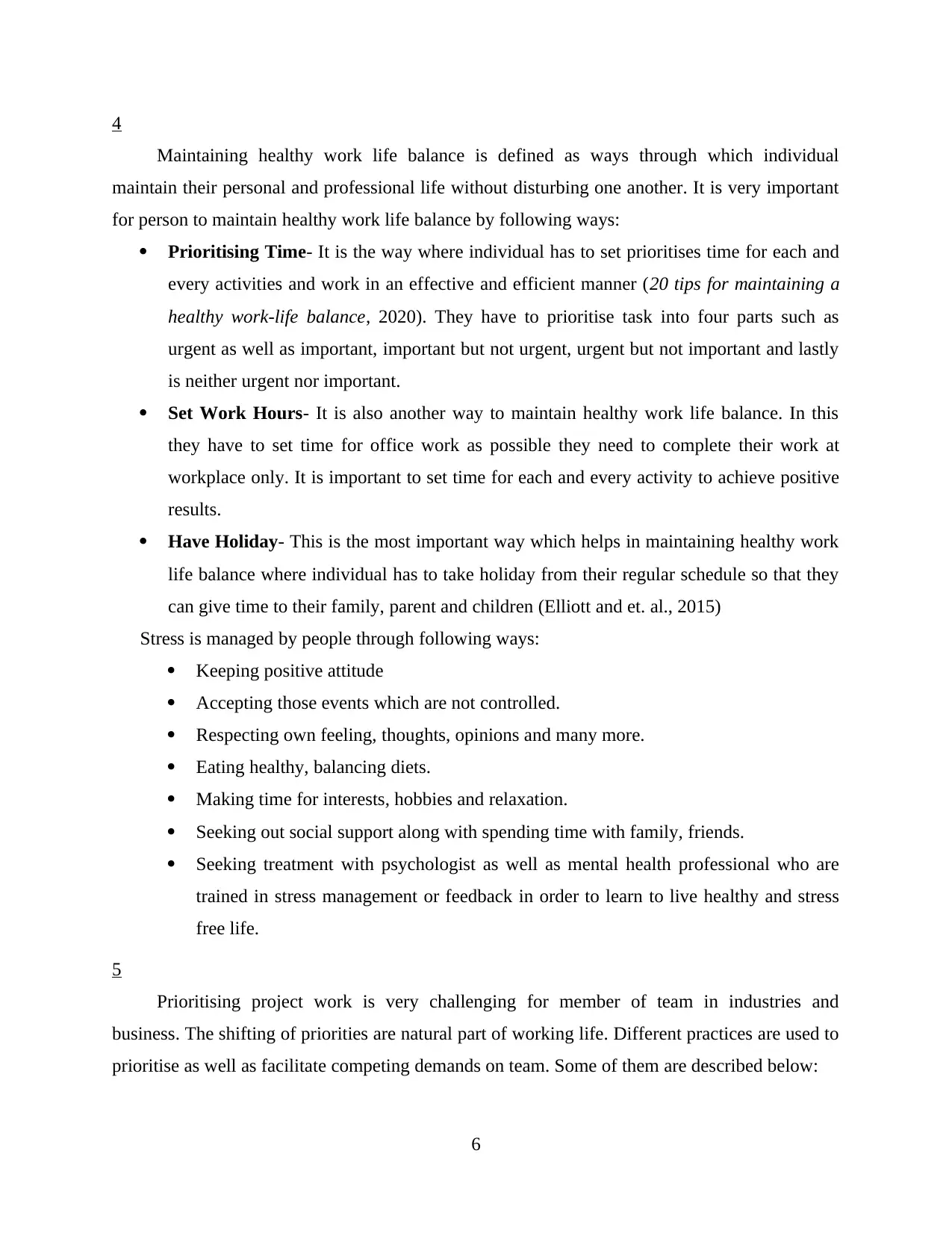
4
Maintaining healthy work life balance is defined as ways through which individual
maintain their personal and professional life without disturbing one another. It is very important
for person to maintain healthy work life balance by following ways:
Prioritising Time- It is the way where individual has to set prioritises time for each and
every activities and work in an effective and efficient manner (20 tips for maintaining a
healthy work-life balance, 2020). They have to prioritise task into four parts such as
urgent as well as important, important but not urgent, urgent but not important and lastly
is neither urgent nor important.
Set Work Hours- It is also another way to maintain healthy work life balance. In this
they have to set time for office work as possible they need to complete their work at
workplace only. It is important to set time for each and every activity to achieve positive
results.
Have Holiday- This is the most important way which helps in maintaining healthy work
life balance where individual has to take holiday from their regular schedule so that they
can give time to their family, parent and children (Elliott and et. al., 2015)
Stress is managed by people through following ways:
Keeping positive attitude
Accepting those events which are not controlled.
Respecting own feeling, thoughts, opinions and many more.
Eating healthy, balancing diets.
Making time for interests, hobbies and relaxation.
Seeking out social support along with spending time with family, friends.
Seeking treatment with psychologist as well as mental health professional who are
trained in stress management or feedback in order to learn to live healthy and stress
free life.
5
Prioritising project work is very challenging for member of team in industries and
business. The shifting of priorities are natural part of working life. Different practices are used to
prioritise as well as facilitate competing demands on team. Some of them are described below:
6
Maintaining healthy work life balance is defined as ways through which individual
maintain their personal and professional life without disturbing one another. It is very important
for person to maintain healthy work life balance by following ways:
Prioritising Time- It is the way where individual has to set prioritises time for each and
every activities and work in an effective and efficient manner (20 tips for maintaining a
healthy work-life balance, 2020). They have to prioritise task into four parts such as
urgent as well as important, important but not urgent, urgent but not important and lastly
is neither urgent nor important.
Set Work Hours- It is also another way to maintain healthy work life balance. In this
they have to set time for office work as possible they need to complete their work at
workplace only. It is important to set time for each and every activity to achieve positive
results.
Have Holiday- This is the most important way which helps in maintaining healthy work
life balance where individual has to take holiday from their regular schedule so that they
can give time to their family, parent and children (Elliott and et. al., 2015)
Stress is managed by people through following ways:
Keeping positive attitude
Accepting those events which are not controlled.
Respecting own feeling, thoughts, opinions and many more.
Eating healthy, balancing diets.
Making time for interests, hobbies and relaxation.
Seeking out social support along with spending time with family, friends.
Seeking treatment with psychologist as well as mental health professional who are
trained in stress management or feedback in order to learn to live healthy and stress
free life.
5
Prioritising project work is very challenging for member of team in industries and
business. The shifting of priorities are natural part of working life. Different practices are used to
prioritise as well as facilitate competing demands on team. Some of them are described below:
6
⊘ This is a preview!⊘
Do you want full access?
Subscribe today to unlock all pages.

Trusted by 1+ million students worldwide
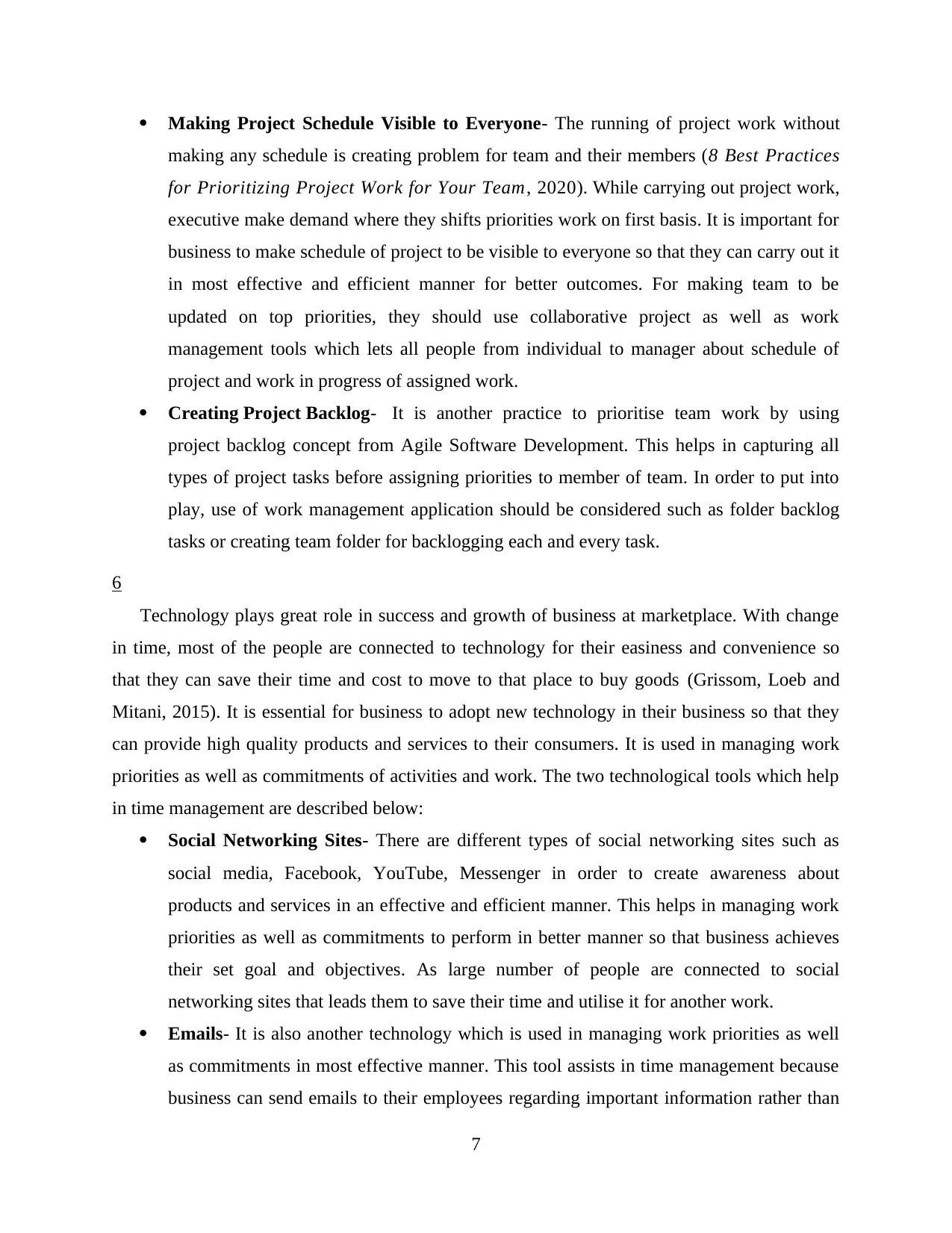
Making Project Schedule Visible to Everyone- The running of project work without
making any schedule is creating problem for team and their members (8 Best Practices
for Prioritizing Project Work for Your Team, 2020). While carrying out project work,
executive make demand where they shifts priorities work on first basis. It is important for
business to make schedule of project to be visible to everyone so that they can carry out it
in most effective and efficient manner for better outcomes. For making team to be
updated on top priorities, they should use collaborative project as well as work
management tools which lets all people from individual to manager about schedule of
project and work in progress of assigned work.
Creating Project Backlog- It is another practice to prioritise team work by using
project backlog concept from Agile Software Development. This helps in capturing all
types of project tasks before assigning priorities to member of team. In order to put into
play, use of work management application should be considered such as folder backlog
tasks or creating team folder for backlogging each and every task.
6
Technology plays great role in success and growth of business at marketplace. With change
in time, most of the people are connected to technology for their easiness and convenience so
that they can save their time and cost to move to that place to buy goods (Grissom, Loeb and
Mitani, 2015). It is essential for business to adopt new technology in their business so that they
can provide high quality products and services to their consumers. It is used in managing work
priorities as well as commitments of activities and work. The two technological tools which help
in time management are described below:
Social Networking Sites- There are different types of social networking sites such as
social media, Facebook, YouTube, Messenger in order to create awareness about
products and services in an effective and efficient manner. This helps in managing work
priorities as well as commitments to perform in better manner so that business achieves
their set goal and objectives. As large number of people are connected to social
networking sites that leads them to save their time and utilise it for another work.
Emails- It is also another technology which is used in managing work priorities as well
as commitments in most effective manner. This tool assists in time management because
business can send emails to their employees regarding important information rather than
7
making any schedule is creating problem for team and their members (8 Best Practices
for Prioritizing Project Work for Your Team, 2020). While carrying out project work,
executive make demand where they shifts priorities work on first basis. It is important for
business to make schedule of project to be visible to everyone so that they can carry out it
in most effective and efficient manner for better outcomes. For making team to be
updated on top priorities, they should use collaborative project as well as work
management tools which lets all people from individual to manager about schedule of
project and work in progress of assigned work.
Creating Project Backlog- It is another practice to prioritise team work by using
project backlog concept from Agile Software Development. This helps in capturing all
types of project tasks before assigning priorities to member of team. In order to put into
play, use of work management application should be considered such as folder backlog
tasks or creating team folder for backlogging each and every task.
6
Technology plays great role in success and growth of business at marketplace. With change
in time, most of the people are connected to technology for their easiness and convenience so
that they can save their time and cost to move to that place to buy goods (Grissom, Loeb and
Mitani, 2015). It is essential for business to adopt new technology in their business so that they
can provide high quality products and services to their consumers. It is used in managing work
priorities as well as commitments of activities and work. The two technological tools which help
in time management are described below:
Social Networking Sites- There are different types of social networking sites such as
social media, Facebook, YouTube, Messenger in order to create awareness about
products and services in an effective and efficient manner. This helps in managing work
priorities as well as commitments to perform in better manner so that business achieves
their set goal and objectives. As large number of people are connected to social
networking sites that leads them to save their time and utilise it for another work.
Emails- It is also another technology which is used in managing work priorities as well
as commitments in most effective manner. This tool assists in time management because
business can send emails to their employees regarding important information rather than
7
Paraphrase This Document
Need a fresh take? Get an instant paraphrase of this document with our AI Paraphraser
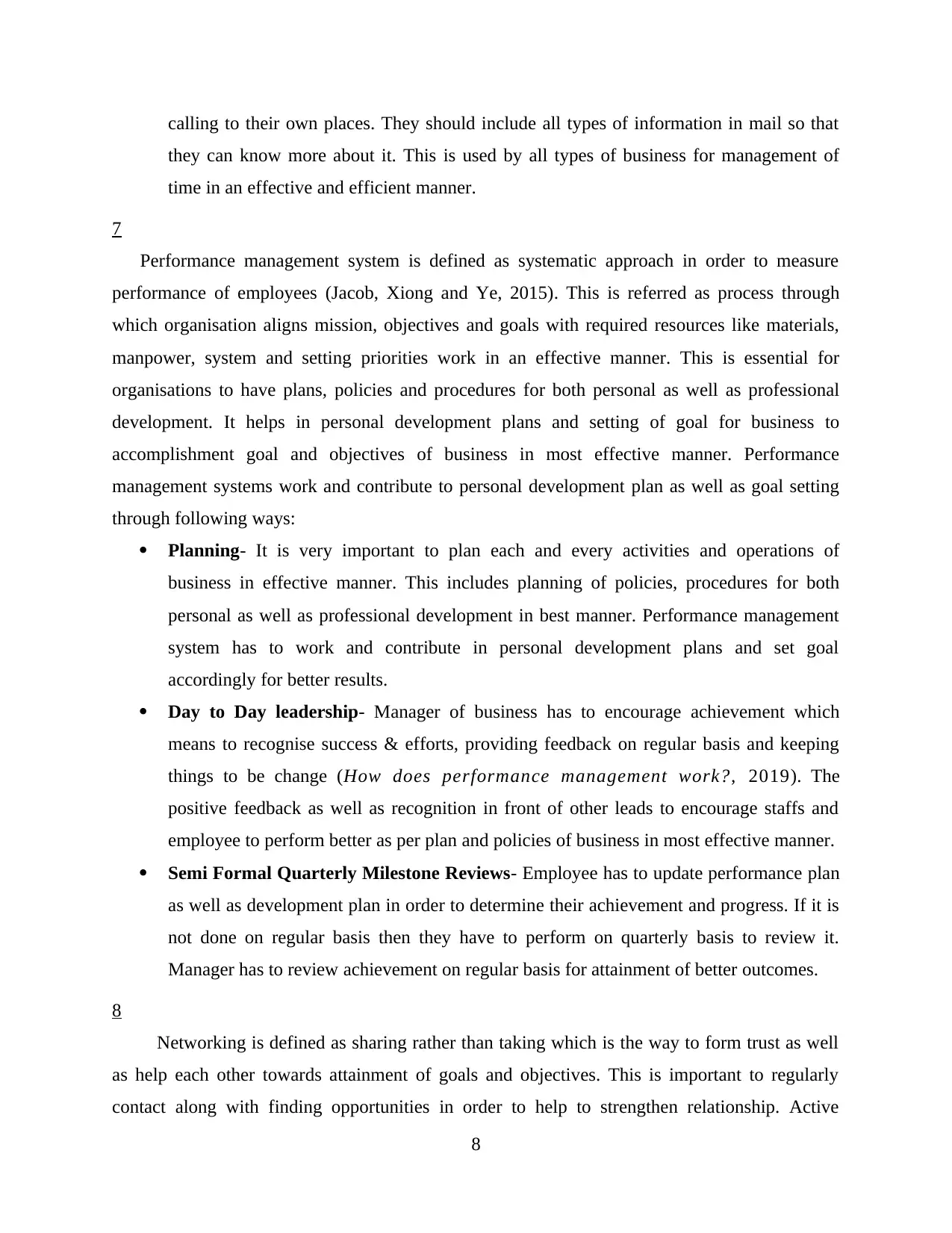
calling to their own places. They should include all types of information in mail so that
they can know more about it. This is used by all types of business for management of
time in an effective and efficient manner.
7
Performance management system is defined as systematic approach in order to measure
performance of employees (Jacob, Xiong and Ye, 2015). This is referred as process through
which organisation aligns mission, objectives and goals with required resources like materials,
manpower, system and setting priorities work in an effective manner. This is essential for
organisations to have plans, policies and procedures for both personal as well as professional
development. It helps in personal development plans and setting of goal for business to
accomplishment goal and objectives of business in most effective manner. Performance
management systems work and contribute to personal development plan as well as goal setting
through following ways:
Planning- It is very important to plan each and every activities and operations of
business in effective manner. This includes planning of policies, procedures for both
personal as well as professional development in best manner. Performance management
system has to work and contribute in personal development plans and set goal
accordingly for better results.
Day to Day leadership- Manager of business has to encourage achievement which
means to recognise success & efforts, providing feedback on regular basis and keeping
things to be change (How does performance management work?, 2019). The
positive feedback as well as recognition in front of other leads to encourage staffs and
employee to perform better as per plan and policies of business in most effective manner.
Semi Formal Quarterly Milestone Reviews- Employee has to update performance plan
as well as development plan in order to determine their achievement and progress. If it is
not done on regular basis then they have to perform on quarterly basis to review it.
Manager has to review achievement on regular basis for attainment of better outcomes.
8
Networking is defined as sharing rather than taking which is the way to form trust as well
as help each other towards attainment of goals and objectives. This is important to regularly
contact along with finding opportunities in order to help to strengthen relationship. Active
8
they can know more about it. This is used by all types of business for management of
time in an effective and efficient manner.
7
Performance management system is defined as systematic approach in order to measure
performance of employees (Jacob, Xiong and Ye, 2015). This is referred as process through
which organisation aligns mission, objectives and goals with required resources like materials,
manpower, system and setting priorities work in an effective manner. This is essential for
organisations to have plans, policies and procedures for both personal as well as professional
development. It helps in personal development plans and setting of goal for business to
accomplishment goal and objectives of business in most effective manner. Performance
management systems work and contribute to personal development plan as well as goal setting
through following ways:
Planning- It is very important to plan each and every activities and operations of
business in effective manner. This includes planning of policies, procedures for both
personal as well as professional development in best manner. Performance management
system has to work and contribute in personal development plans and set goal
accordingly for better results.
Day to Day leadership- Manager of business has to encourage achievement which
means to recognise success & efforts, providing feedback on regular basis and keeping
things to be change (How does performance management work?, 2019). The
positive feedback as well as recognition in front of other leads to encourage staffs and
employee to perform better as per plan and policies of business in most effective manner.
Semi Formal Quarterly Milestone Reviews- Employee has to update performance plan
as well as development plan in order to determine their achievement and progress. If it is
not done on regular basis then they have to perform on quarterly basis to review it.
Manager has to review achievement on regular basis for attainment of better outcomes.
8
Networking is defined as sharing rather than taking which is the way to form trust as well
as help each other towards attainment of goals and objectives. This is important to regularly
contact along with finding opportunities in order to help to strengthen relationship. Active
8
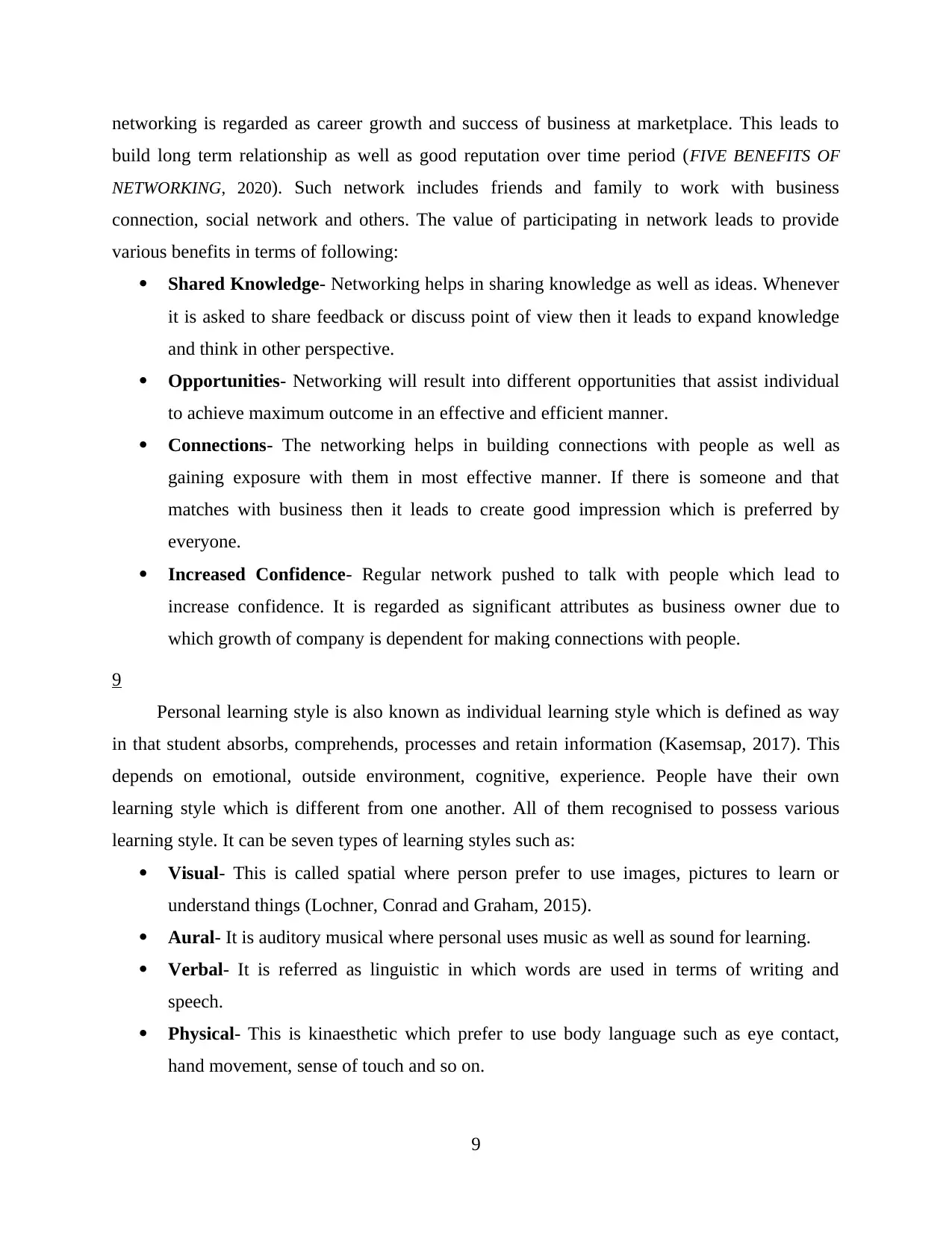
networking is regarded as career growth and success of business at marketplace. This leads to
build long term relationship as well as good reputation over time period (FIVE BENEFITS OF
NETWORKING, 2020). Such network includes friends and family to work with business
connection, social network and others. The value of participating in network leads to provide
various benefits in terms of following:
Shared Knowledge- Networking helps in sharing knowledge as well as ideas. Whenever
it is asked to share feedback or discuss point of view then it leads to expand knowledge
and think in other perspective.
Opportunities- Networking will result into different opportunities that assist individual
to achieve maximum outcome in an effective and efficient manner.
Connections- The networking helps in building connections with people as well as
gaining exposure with them in most effective manner. If there is someone and that
matches with business then it leads to create good impression which is preferred by
everyone.
Increased Confidence- Regular network pushed to talk with people which lead to
increase confidence. It is regarded as significant attributes as business owner due to
which growth of company is dependent for making connections with people.
9
Personal learning style is also known as individual learning style which is defined as way
in that student absorbs, comprehends, processes and retain information (Kasemsap, 2017). This
depends on emotional, outside environment, cognitive, experience. People have their own
learning style which is different from one another. All of them recognised to possess various
learning style. It can be seven types of learning styles such as:
Visual- This is called spatial where person prefer to use images, pictures to learn or
understand things (Lochner, Conrad and Graham, 2015).
Aural- It is auditory musical where personal uses music as well as sound for learning.
Verbal- It is referred as linguistic in which words are used in terms of writing and
speech.
Physical- This is kinaesthetic which prefer to use body language such as eye contact,
hand movement, sense of touch and so on.
9
build long term relationship as well as good reputation over time period (FIVE BENEFITS OF
NETWORKING, 2020). Such network includes friends and family to work with business
connection, social network and others. The value of participating in network leads to provide
various benefits in terms of following:
Shared Knowledge- Networking helps in sharing knowledge as well as ideas. Whenever
it is asked to share feedback or discuss point of view then it leads to expand knowledge
and think in other perspective.
Opportunities- Networking will result into different opportunities that assist individual
to achieve maximum outcome in an effective and efficient manner.
Connections- The networking helps in building connections with people as well as
gaining exposure with them in most effective manner. If there is someone and that
matches with business then it leads to create good impression which is preferred by
everyone.
Increased Confidence- Regular network pushed to talk with people which lead to
increase confidence. It is regarded as significant attributes as business owner due to
which growth of company is dependent for making connections with people.
9
Personal learning style is also known as individual learning style which is defined as way
in that student absorbs, comprehends, processes and retain information (Kasemsap, 2017). This
depends on emotional, outside environment, cognitive, experience. People have their own
learning style which is different from one another. All of them recognised to possess various
learning style. It can be seven types of learning styles such as:
Visual- This is called spatial where person prefer to use images, pictures to learn or
understand things (Lochner, Conrad and Graham, 2015).
Aural- It is auditory musical where personal uses music as well as sound for learning.
Verbal- It is referred as linguistic in which words are used in terms of writing and
speech.
Physical- This is kinaesthetic which prefer to use body language such as eye contact,
hand movement, sense of touch and so on.
9
⊘ This is a preview!⊘
Do you want full access?
Subscribe today to unlock all pages.

Trusted by 1+ million students worldwide
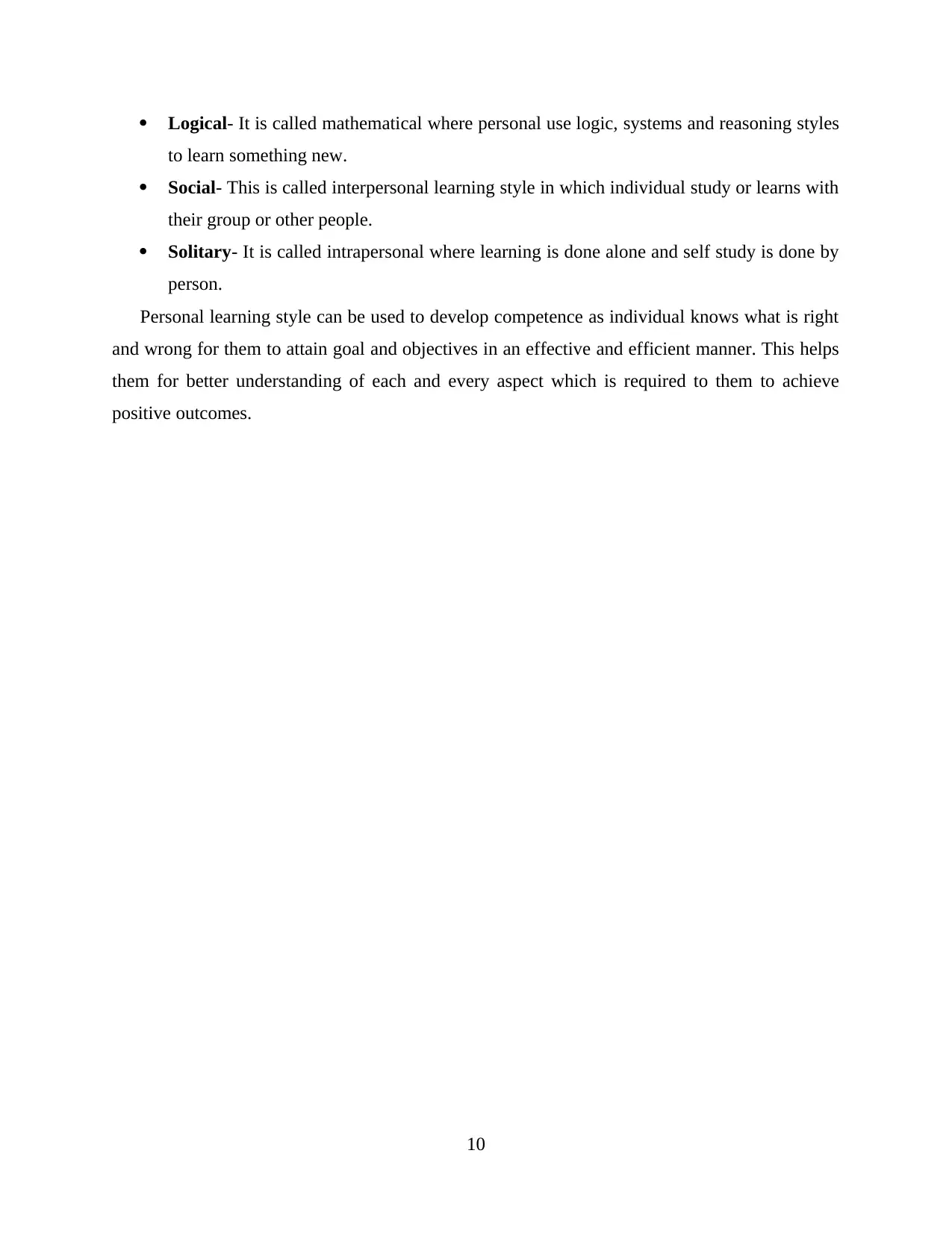
Logical- It is called mathematical where personal use logic, systems and reasoning styles
to learn something new.
Social- This is called interpersonal learning style in which individual study or learns with
their group or other people.
Solitary- It is called intrapersonal where learning is done alone and self study is done by
person.
Personal learning style can be used to develop competence as individual knows what is right
and wrong for them to attain goal and objectives in an effective and efficient manner. This helps
them for better understanding of each and every aspect which is required to them to achieve
positive outcomes.
10
to learn something new.
Social- This is called interpersonal learning style in which individual study or learns with
their group or other people.
Solitary- It is called intrapersonal where learning is done alone and self study is done by
person.
Personal learning style can be used to develop competence as individual knows what is right
and wrong for them to attain goal and objectives in an effective and efficient manner. This helps
them for better understanding of each and every aspect which is required to them to achieve
positive outcomes.
10
Paraphrase This Document
Need a fresh take? Get an instant paraphrase of this document with our AI Paraphraser
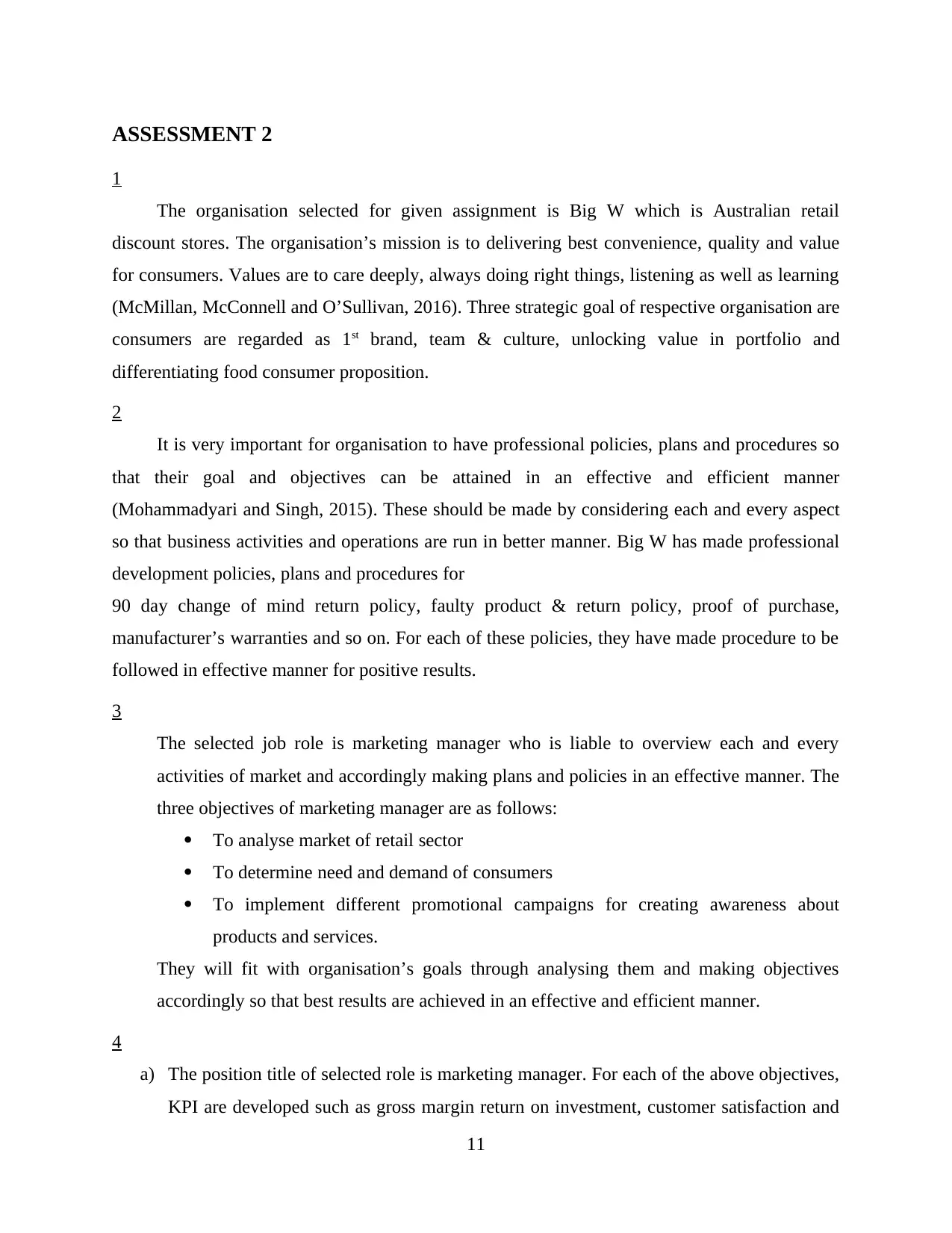
ASSESSMENT 2
1
The organisation selected for given assignment is Big W which is Australian retail
discount stores. The organisation’s mission is to delivering best convenience, quality and value
for consumers. Values are to care deeply, always doing right things, listening as well as learning
(McMillan, McConnell and O’Sullivan, 2016). Three strategic goal of respective organisation are
consumers are regarded as 1st brand, team & culture, unlocking value in portfolio and
differentiating food consumer proposition.
2
It is very important for organisation to have professional policies, plans and procedures so
that their goal and objectives can be attained in an effective and efficient manner
(Mohammadyari and Singh, 2015). These should be made by considering each and every aspect
so that business activities and operations are run in better manner. Big W has made professional
development policies, plans and procedures for
90 day change of mind return policy, faulty product & return policy, proof of purchase,
manufacturer’s warranties and so on. For each of these policies, they have made procedure to be
followed in effective manner for positive results.
3
The selected job role is marketing manager who is liable to overview each and every
activities of market and accordingly making plans and policies in an effective manner. The
three objectives of marketing manager are as follows:
To analyse market of retail sector
To determine need and demand of consumers
To implement different promotional campaigns for creating awareness about
products and services.
They will fit with organisation’s goals through analysing them and making objectives
accordingly so that best results are achieved in an effective and efficient manner.
4
a) The position title of selected role is marketing manager. For each of the above objectives,
KPI are developed such as gross margin return on investment, customer satisfaction and
11
1
The organisation selected for given assignment is Big W which is Australian retail
discount stores. The organisation’s mission is to delivering best convenience, quality and value
for consumers. Values are to care deeply, always doing right things, listening as well as learning
(McMillan, McConnell and O’Sullivan, 2016). Three strategic goal of respective organisation are
consumers are regarded as 1st brand, team & culture, unlocking value in portfolio and
differentiating food consumer proposition.
2
It is very important for organisation to have professional policies, plans and procedures so
that their goal and objectives can be attained in an effective and efficient manner
(Mohammadyari and Singh, 2015). These should be made by considering each and every aspect
so that business activities and operations are run in better manner. Big W has made professional
development policies, plans and procedures for
90 day change of mind return policy, faulty product & return policy, proof of purchase,
manufacturer’s warranties and so on. For each of these policies, they have made procedure to be
followed in effective manner for positive results.
3
The selected job role is marketing manager who is liable to overview each and every
activities of market and accordingly making plans and policies in an effective manner. The
three objectives of marketing manager are as follows:
To analyse market of retail sector
To determine need and demand of consumers
To implement different promotional campaigns for creating awareness about
products and services.
They will fit with organisation’s goals through analysing them and making objectives
accordingly so that best results are achieved in an effective and efficient manner.
4
a) The position title of selected role is marketing manager. For each of the above objectives,
KPI are developed such as gross margin return on investment, customer satisfaction and
11
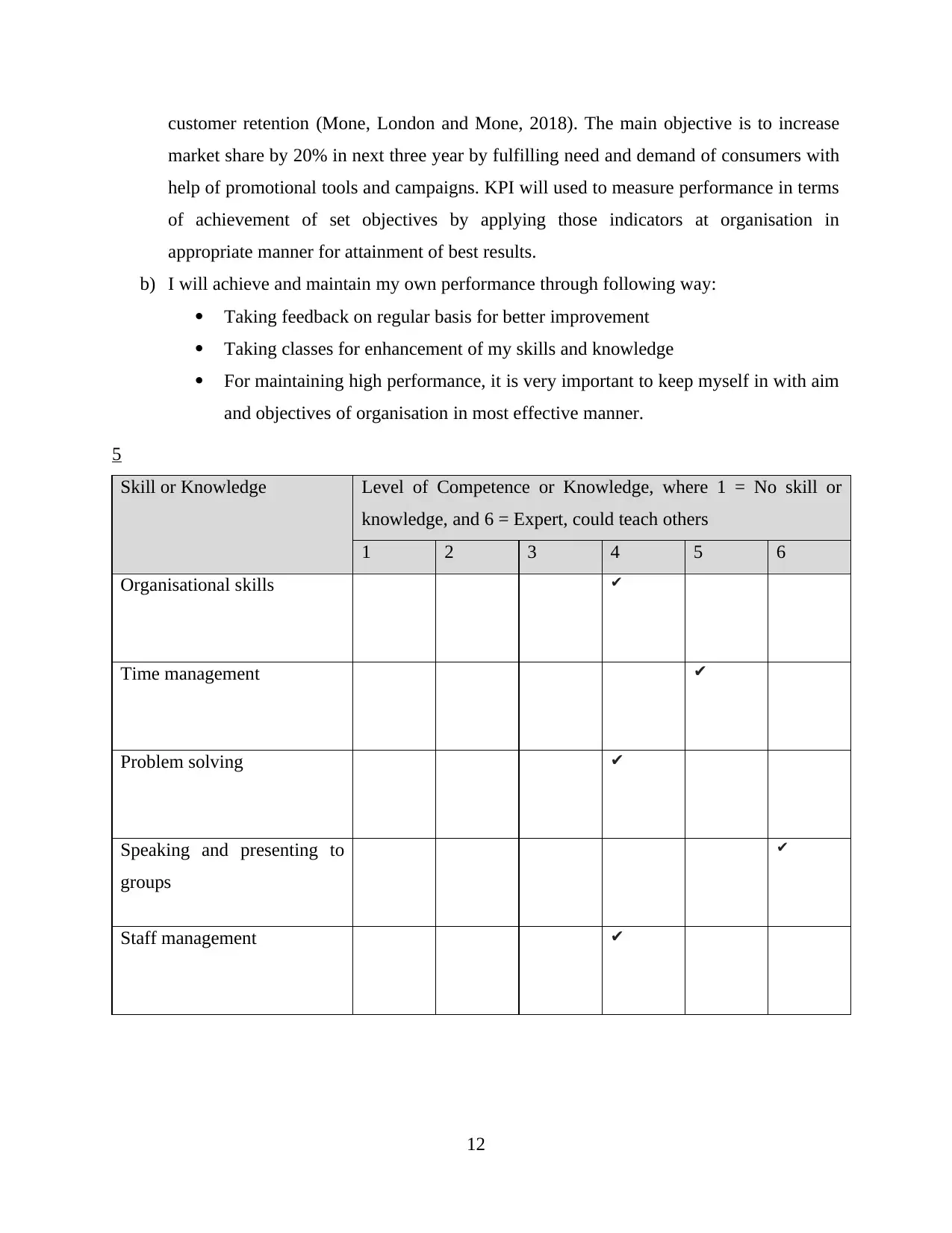
customer retention (Mone, London and Mone, 2018). The main objective is to increase
market share by 20% in next three year by fulfilling need and demand of consumers with
help of promotional tools and campaigns. KPI will used to measure performance in terms
of achievement of set objectives by applying those indicators at organisation in
appropriate manner for attainment of best results.
b) I will achieve and maintain my own performance through following way:
Taking feedback on regular basis for better improvement
Taking classes for enhancement of my skills and knowledge
For maintaining high performance, it is very important to keep myself in with aim
and objectives of organisation in most effective manner.
5
Skill or Knowledge Level of Competence or Knowledge, where 1 = No skill or
knowledge, and 6 = Expert, could teach others
1 2 3 4 5 6
Organisational skills ✔
Time management ✔
Problem solving ✔
Speaking and presenting to
groups
✔
Staff management ✔
12
market share by 20% in next three year by fulfilling need and demand of consumers with
help of promotional tools and campaigns. KPI will used to measure performance in terms
of achievement of set objectives by applying those indicators at organisation in
appropriate manner for attainment of best results.
b) I will achieve and maintain my own performance through following way:
Taking feedback on regular basis for better improvement
Taking classes for enhancement of my skills and knowledge
For maintaining high performance, it is very important to keep myself in with aim
and objectives of organisation in most effective manner.
5
Skill or Knowledge Level of Competence or Knowledge, where 1 = No skill or
knowledge, and 6 = Expert, could teach others
1 2 3 4 5 6
Organisational skills ✔
Time management ✔
Problem solving ✔
Speaking and presenting to
groups
✔
Staff management ✔
12
⊘ This is a preview!⊘
Do you want full access?
Subscribe today to unlock all pages.

Trusted by 1+ million students worldwide
1 out of 21
Related Documents
Your All-in-One AI-Powered Toolkit for Academic Success.
+13062052269
info@desklib.com
Available 24*7 on WhatsApp / Email
![[object Object]](/_next/static/media/star-bottom.7253800d.svg)
Unlock your academic potential
Copyright © 2020–2025 A2Z Services. All Rights Reserved. Developed and managed by ZUCOL.



